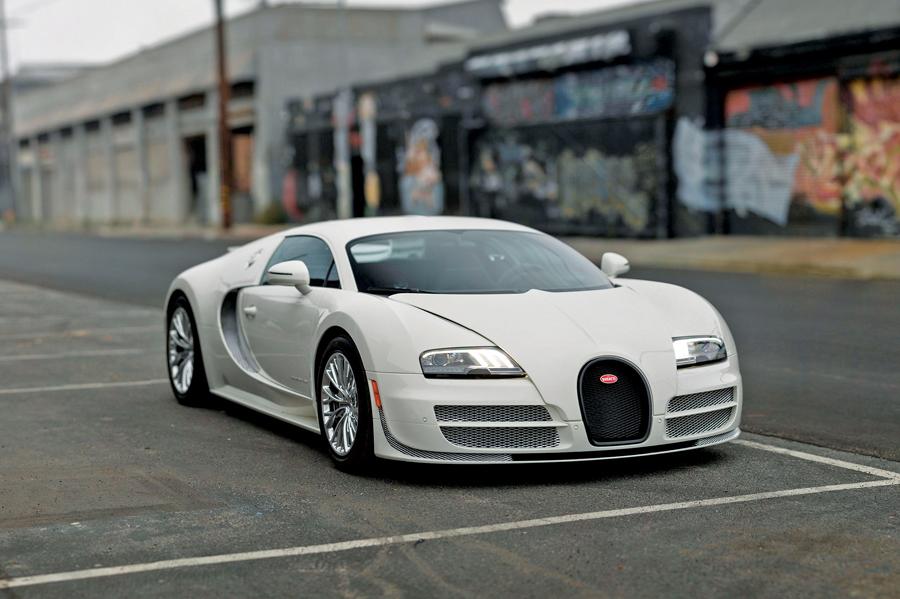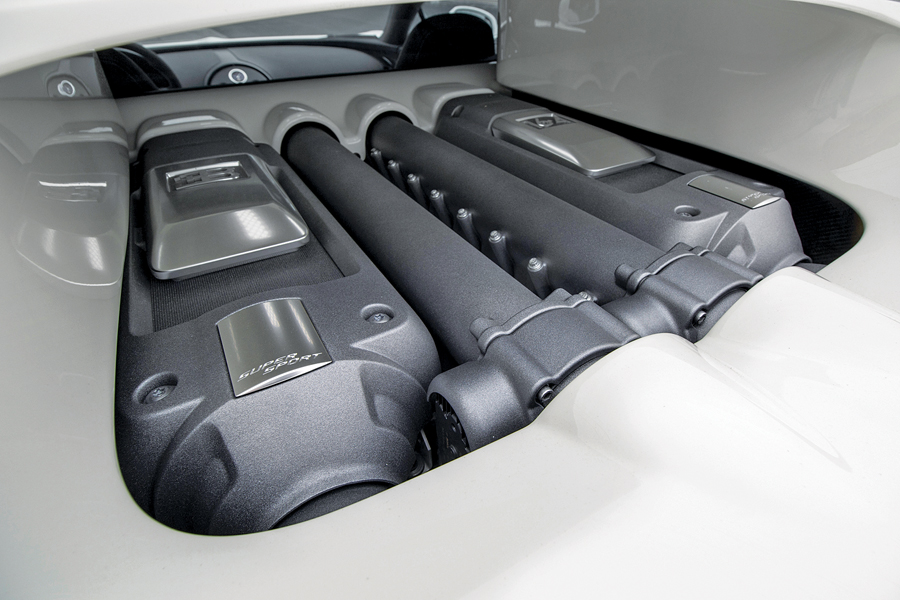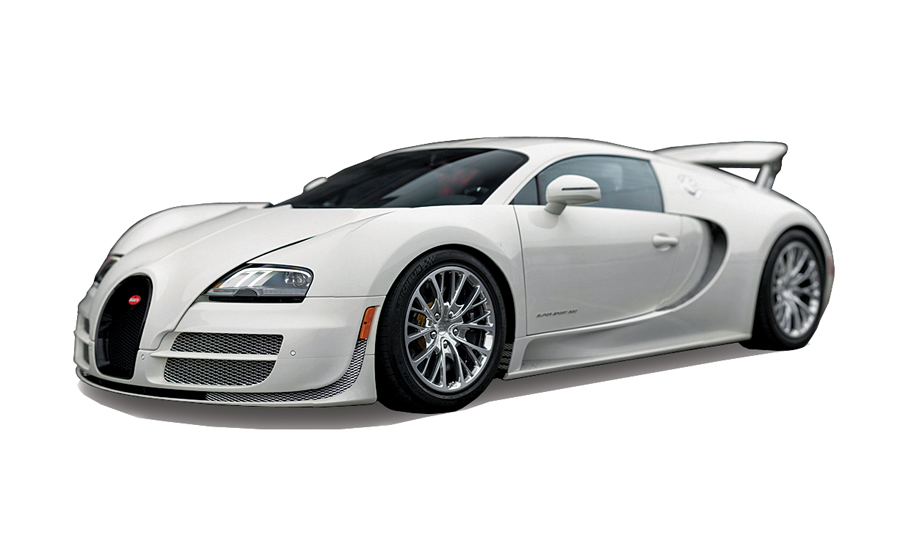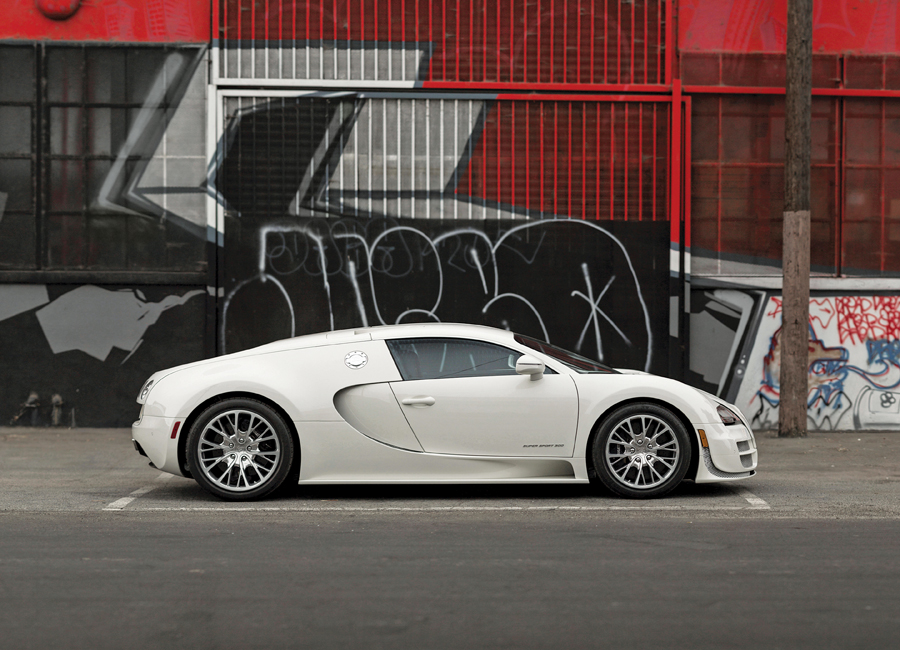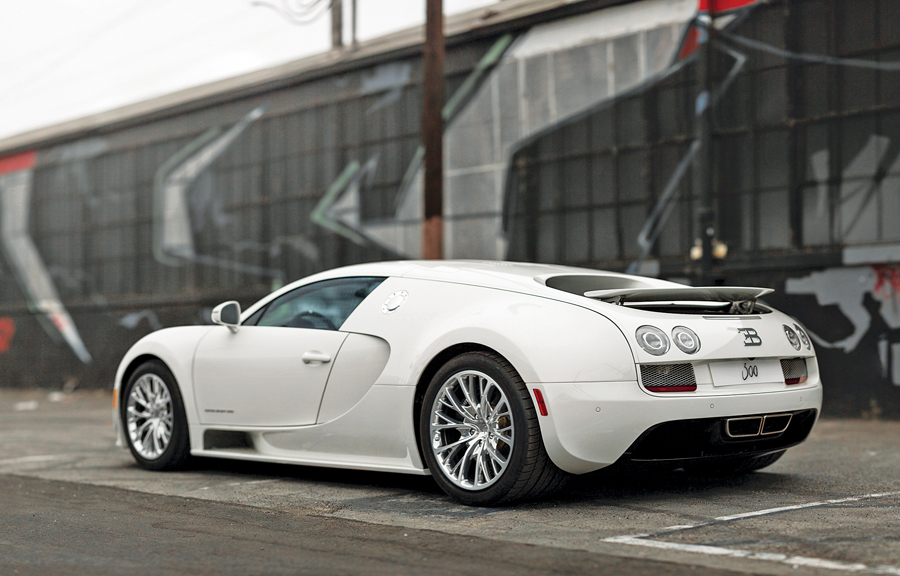This Veyron was purchased new by its first owner and delivered in August 2012. It was born as one of 48 1,200-horsepower Veyron 16.4 Super Sports and was one of eight delivered new to the United States, perhaps being the only example in this color combination.
As evidenced by documentation accompanying the car, 269 of the current miles driven were accumulated by Bugatti at Molsheim during Bugatti’s standard and extensive pre-delivery testing. As a result, it is presented in virtually as-new condition. Since its delivery, it has been very well preserved and regularly maintained. Braman Bugatti in Miami carried out its annual service in November 2013, and it received another annual service by them in May 2015. The Veyron was acquired by the current vendor in August 2015 and was serviced by Bentley Beverly Hills in May of this year.
SCM Analysis
Detailing
| Vehicle: | 2013 Bugatti Veyron 16.4 Super Sport 300 |
| Years Produced: | 2005–15 |
| Number Produced: | 300 |
| Original List Price: | 1.4 million euros |
| SCM Valuation: | $2,200,000 |
| Tune Up Cost: | Included in purchase price |
| Chassis Number Location: | VIN tag in left front corner of windshield |
| Club Info: | American Bugatti Club (although you’d look very out of place) |
| Website: | http://www.americanbugatticlub.org |
| Alternatives: | 2013 Ferrari La Ferrari, 2013–15 McLaren P1, 1992–95 Bugatti EB110 |
| Investment Grade: | B |
This car, Lot 228, sold for $2,090,000, including buyer’s premium, at RM Sotheby’s auction in Phoenix, AZ, on January 20, 2017.
In August 2008, the Bugatti Veyron Grand Sport was unveiled at the Pebble Beach Concours d’Elegance, and that Sunday evening, Gooding & Company auctioned off Chassis 001. The car sold for an astonishing $3,190,000, and it set the tone for “unique” Veyrons at auction.
Few have come to public sale, and you have to go back to 2013 to find an auction result for less than $1 million. Additionally, the lowest public result of a Grand Sport was in August 2013 at $1,155,000.
Since then, we’ve seen two “one-off” Veyrons sell for over $2m. The Bleu Nuit Grand Sport brought $2.31m at RM Sotheby’s November 2013 New York sale, and the Grand Sport Vitesse “Le Ciel Californien” brought $2.42m at RM Sotheby’s Monterey auction in 2014.)
Aside from the standard Veyrons, only two other Grand Sports or Super Sports have surfaced for public sale, the first being our subject vehicle.
Notable as the final Veyron coupe constructed, our subject Super Sport 300 was featured among a heavy lineup in RM Sotheby’s Pinnacle Portfolio offered at their 2015 Monterey auction. The car, offered out of single ownership, brought an expected result of $2.31m, generally affirming the going price for a differentiated example.
Some 17 months later, Super Sport 300 came back on the market. And other than a service performed at Bentley Beverly Hills, the car was virtually unchanged from its prior appearance on the auction block, with little accrued mileage to note.
Initially offered in 2015 with a $2.5m–$3m estimate, the car’s new $2.1m–$2.3m spread reflected that RM Sotheby’s and the seller understood that sale price expectations should be kept in check in 2017.
The Veyron sold for an all-in price of $2,090,000 — a figure in line with market results, and perhaps tempered a bit by the car’s second offering.
Today’s collector car market
While I find the Super Sport’s sale very expected, the result is an interesting study of the market in 2017. Since the Arizona Auction Week, I’ve heard a fair number of people circulating the general “down 20%–30%” recap. I’m not necessarily arguing that’s right or wrong, but I prefer we not look at the market so simplistically.
For example, the sale of this Veyron would say otherwise, particularly given that fresh-to-market is a necessity for a strong result.
During the auction week, I attended the Worldwide Auctioneers, Bonhams, RM Sotheby’s and Gooding & Company sales, and I watched the auction companies working very hard against expectations put in place months earlier. And while one may look at the sales results versus the printed estimate and see lackluster performance, I see reality.
If the reserve adjustments made in the auction room had taken place when the catalogs were being printed, the collective outlook would be much rosier.
Now, I haven’t been diligently crunching numbers since I got home from Scottsdale. And my theory on managing sellers’ expectations may further support the “20%–30% adjustment.” But I’m most eager, however, to read what my fellow contributors offer up in summary of the week. Because this isn’t just a numbers game, and data points alone cannot reflect the sheer diversity of cars on offer.
I have two big takeaways from 2017’s market opener:
First, I see consistency in the tempered results. When buyers feel they have options, more rational decisions are made. The broad growth we’ve seen in the market just wasn’t sustainable, and the playing field has leveled substantially in the buyer’s favor. Rational sellers are finding success in that understanding.
Second, and most important, today’s market confirms that the “best of the best” is always desired — and hotly contested. Perhaps the healthiest indicator in recent results is the value spread between poor, average, good and great examples of the same model. And that makes differentiating amongst more modern “production” cars a challenge — no matter how limited production figures are.
The new supercar market
I’ve written before that I find the supercar market perplexing — it’s merely an options and mileage game. But the Veyron has been an interesting performer in that regard, in part due to the more readily differentiating traits among examples.
Contemporary, low-production automobiles, many of which are classified as supercars, have appealed to an increasingly broader market. For the most part, a “collector car” used to be anything built before about 1970. In less than 10 years that cut-off has jumped over four decades to seemingly include anything interesting and built in limited numbers. For many cars, the attention was long overdue.
But manufacturers can’t seem to build the next “collectible” quickly enough. Whether it’s the GT3RS or 911R, or the La Ferrari and Chiron, demand is undoubtedly high.
This new market is really a different market
And we have to remember, this sector is actually a different market altogether.
The list of elite clientele at today’s luxury manufacturers looks a lot different than that of registered bidders at the auctions we frequent. Not to say there isn’t some overlap, but maybe the most notable difference is the depth of those respective markets.
The global market for luxury goods drives the prices for the contemporary supercars. And the level of wealth actively engaged in that sphere makes our $261m Arizona Auction Week look miniscule.
So when a Bugatti Veyron or La Ferrari or P1 comes up for sale at a “collector car auction,” there are more outside contributing factors at play than what we see with something as universal as a Mercedes-Benz 300SL Gullwing.
A long-term Ferrari collector bidding on an Enzo isn’t necessarily competing with the Forbes list, paddles in hand, but they have influenced the price he, or she, will have to pay for the car. So when these cars cross the auction block, it is simply a question of whether our hobby will absorb them at the going rate.
The economics of it all are far beyond me. So if you’re looking for a blanket “buy supercars” or “sell your Veyron now,” you won’t get it here. But what I will say is perhaps fairly obvious — the value of these cars has far less to do with our little car market and much more to do with everything else.
With growing differentiation in the market and more outside factors at play than ever before, perhaps diversification is the safest bet. And that alone has and will continue to contribute to the prevalence of more modern cars in our hobby.
Helping to drive this growing diversification is collectors’ desire for varied experiences from their collection. I know several London-to-Brighton participants who own McLaren F1s, and I’m pretty sure that’s not something I would have said 10 years ago.
It’s a wonderful thing to see. ♦
(Introductory description courtesy of RM Sotheby’s.)
